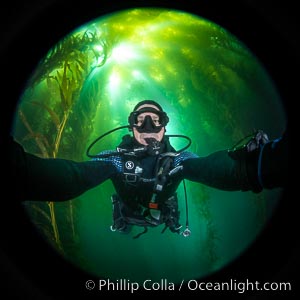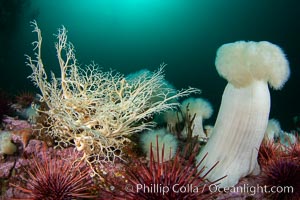
Basket Star and Giant Metridium anemone, Browning Pass, Vancouver Island.
Species: Basket star, Giant plumose anemone, Gorgonocephalus eucnemis, Metridium farcimen
Location: British Columbia, Canada
Image ID: 35287
Species: Basket star, Giant plumose anemone, Gorgonocephalus eucnemis, Metridium farcimen
Location: British Columbia, Canada
Image ID: 35287
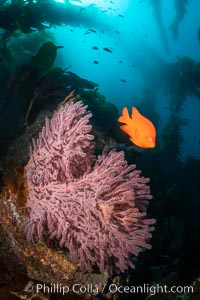
Garibaldi and Brown Gorgonian Muricea fruticosa, Catalina Island, with giant kelp stands reaching from the reef to the surface of the ocean in the distance. The clown prince of the kelp forest, the Garibaldi, alternately poses for me and chirps at me to move away from his gorgonian.
Location: Catalina Island, California
Image ID: 37157
Location: Catalina Island, California
Image ID: 37157
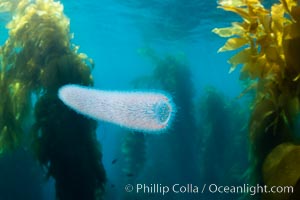
Pyrosome drifting through a kelp forest, Catalina Island. Pyrosomes are free-floating colonial tunicates that usually live in the upper layers of the open ocean in warm seas. Pyrosomes are cylindrical or cone-shaped colonies made up of hundreds to thousands of individuals, known as zooids.
Location: Catalina Island, California
Image ID: 37166
Location: Catalina Island, California
Image ID: 37166
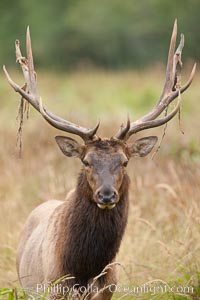
Roosevelt elk, adult bull male with large antlers. This bull elk has recently shed the velvet that covers its antlers. While an antler is growing, it is covered with highly vascular skin called velvet, which supplies oxygen and nutrients to the growing bone; once the antler has achieved its full size, the velvet is lost and the antler's bone dies. This dead bone structure is the mature antler, which is itself shed after each mating season. Roosevelt elk grow to 10' and 1300 lb, eating grasses, sedges and various berries, inhabiting the coastal rainforests of the Pacific Northwest.
Species: Roosevelt elk, Cervus canadensis roosevelti
Location: Redwood National Park, California
Image ID: 25890
Species: Roosevelt elk, Cervus canadensis roosevelti
Location: Redwood National Park, California
Image ID: 25890
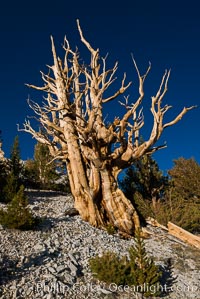
Ancient bristlecone pine trees in Patriarch Grove, display characteristic gnarled, twisted form as it rises above the arid, dolomite-rich slopes of the White Mountains at 11000-foot elevation. Patriarch Grove, Ancient Bristlecone Pine Forest.
Species: Ancient bristlecone pine, Pinus longaeva
Location: White Mountains, Inyo National Forest, California
Image ID: 28526
Species: Ancient bristlecone pine, Pinus longaeva
Location: White Mountains, Inyo National Forest, California
Image ID: 28526

San Diego city skyline, showing the buildings of downtown San Diego rising above San Diego Harbor, viewed from Point Loma at sunset, with mountains of the Cleveland National Forest rising in the distance. A panoramic photograph, composite of six separate images. Mount San Miguel is on right and Lyons Peak to the left.
Location: San Diego, California
Image ID: 22252
Panorama dimensions: 3144 x 16621
Location: San Diego, California
Image ID: 22252
Panorama dimensions: 3144 x 16621
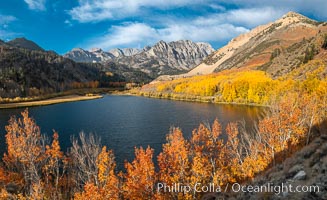
Sierra Nevada Fall Colors, North Lake, Bishop Creek Canyon.
Species: Quaking aspen, Populus tremuloides
Location: Bishop Creek Canyon, Sierra Nevada Mountains, California
Image ID: 36437
Panorama dimensions: 6440 x 10545
Species: Quaking aspen, Populus tremuloides
Location: Bishop Creek Canyon, Sierra Nevada Mountains, California
Image ID: 36437
Panorama dimensions: 6440 x 10545
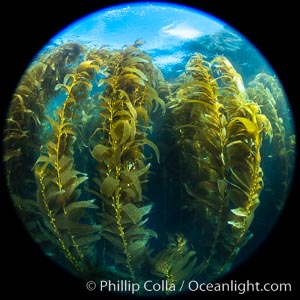
Giant Kelp Forest, West End Catalina Island, rendered in the round by a circular fisheye lens.
Species: Giant kelp, Macrocystis pyrifera
Location: Catalina Island, California
Image ID: 37279
Species: Giant kelp, Macrocystis pyrifera
Location: Catalina Island, California
Image ID: 37279
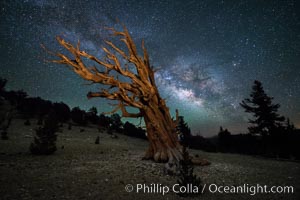
Milky Way over Ancient Bristlecone Pine Trees, Inyo National Forest.
Species: Bristlecone pine, Pinus longaeva
Location: Ancient Bristlecone Pine Forest, White Mountains, Inyo National Forest, California
Image ID: 29318
Species: Bristlecone pine, Pinus longaeva
Location: Ancient Bristlecone Pine Forest, White Mountains, Inyo National Forest, California
Image ID: 29318
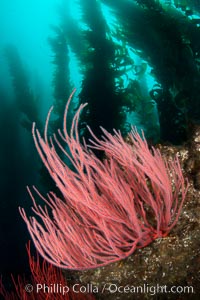
Red gorgonian on rocky reef, below kelp forest, underwater. The red gorgonian is a filter-feeding temperate colonial species that lives on the rocky bottom at depths between 50 to 200 feet deep. Gorgonians are oriented at right angles to prevailing water currents to capture plankton drifting by.
Species: Red gorgonian, Leptogorgia chilensis, Lophogorgia chilensis
Location: San Clemente Island, California
Image ID: 25394
Species: Red gorgonian, Leptogorgia chilensis, Lophogorgia chilensis
Location: San Clemente Island, California
Image ID: 25394
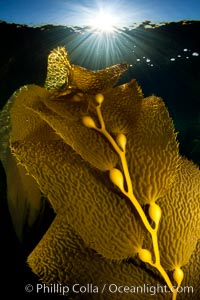
Kelp fronds and pneumatocysts. Pneumatocysts, gas-filled bladders, float the kelp plant off the ocean bottom toward the surface and sunlight, where the leaf-like blades and stipes of the kelp plant grow fastest. Giant kelp can grow up to 2' in a single day given optimal conditions. Epic submarine forests of kelp grow throughout California's Southern Channel Islands.
Species: Giant kelp, Macrocystis pyrifera
Location: San Clemente Island, California
Image ID: 25396
Species: Giant kelp, Macrocystis pyrifera
Location: San Clemente Island, California
Image ID: 25396
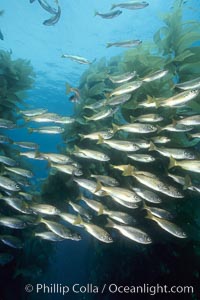
Salema schooling amid kelp forest.
Species: Salema, Macrocystis pyrifera, Xenistius californiensis
Location: Catalina Island, California
Image ID: 01022
Species: Salema, Macrocystis pyrifera, Xenistius californiensis
Location: Catalina Island, California
Image ID: 01022
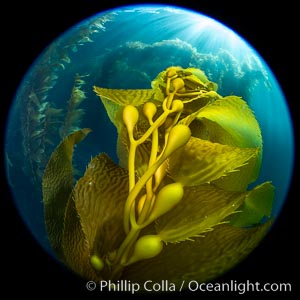
Kelp fronds and pneumatocysts. Pneumatocysts, gas-filled bladders, float the kelp off the ocean bottom toward the surface and sunlight, where the leaf-like blades and stipes of the kelp plant grow fastest. Catalina Island, California.
Species: Giant kelp, Macrocystis pyrifera
Location: Catalina Island, California
Image ID: 37282
Species: Giant kelp, Macrocystis pyrifera
Location: Catalina Island, California
Image ID: 37282
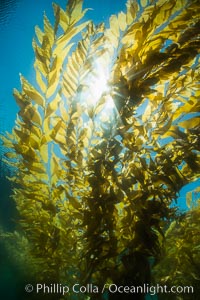
The Kelp Forest offshore of La Jolla, California. A kelp forest. Giant kelp grows rapidly, up to 2' per day, from the rocky reef on the ocean bottom to which it is anchored, toward the ocean surface where it spreads to form a thick canopy. Myriad species of fishes, mammals and invertebrates form a rich community in the kelp forest. Lush forests of kelp are found throughout California's Southern Channel Islands.
Species: Giant kelp, Macrocystis pyrifera
Image ID: 30986
Species: Giant kelp, Macrocystis pyrifera
Image ID: 30986
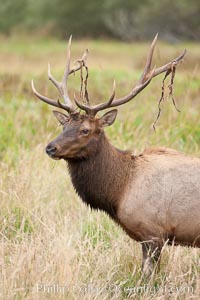
Roosevelt elk, adult bull male with large antlers. This bull elk has recently shed the velvet that covers its antlers. While an antler is growing, it is covered with highly vascular skin called velvet, which supplies oxygen and nutrients to the growing bone; once the antler has achieved its full size, the velvet is lost and the antler's bone dies. This dead bone structure is the mature antler, which is itself shed after each mating season. Roosevelt elk grow to 10' and 1300 lb, eating grasses, sedges and various berries, inhabiting the coastal rainforests of the Pacific Northwest.
Species: Roosevelt elk, Cervus canadensis roosevelti
Location: Redwood National Park, California
Image ID: 25878
Species: Roosevelt elk, Cervus canadensis roosevelti
Location: Redwood National Park, California
Image ID: 25878
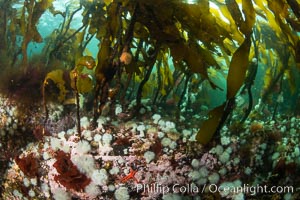
Metridium senile anemones cover the reef below a forest of bull kelp, Browning Pass, Vancouver Island.
Species: Bull kelp, Plumose anemone, Metridium senile, Nereocystis luetkeana
Location: British Columbia, Canada
Image ID: 35289
Species: Bull kelp, Plumose anemone, Metridium senile, Nereocystis luetkeana
Location: British Columbia, Canada
Image ID: 35289
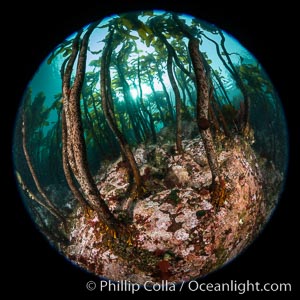
A forest of bull kelp rises above a colorful cold water reef, rich with invertebrate life. Browning Pass, Vancouver Island.
Species: Bull kelp, Nereocystis luetkeana
Location: British Columbia, Canada
Image ID: 35295
Species: Bull kelp, Nereocystis luetkeana
Location: British Columbia, Canada
Image ID: 35295
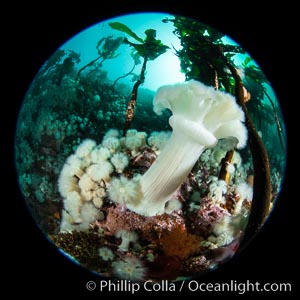
A forest of bull kelp rises above a colorful cold water reef, rich with invertebrate life. Browning Pass, Vancouver Island.
Species: Bull kelp, Giant plumose anemone, Metridium farcimen, Nereocystis luetkeana
Location: British Columbia, Canada
Image ID: 35299
Species: Bull kelp, Giant plumose anemone, Metridium farcimen, Nereocystis luetkeana
Location: British Columbia, Canada
Image ID: 35299
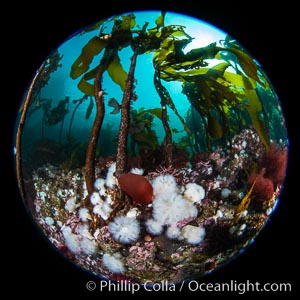
Metridium senile anemones cover the reef below a forest of bull kelp, Browning Pass, Vancouver Island.
Species: Bull kelp, Plumose anemone, Metridium senile, Nereocystis luetkeana
Location: British Columbia, Canada
Image ID: 35300
Species: Bull kelp, Plumose anemone, Metridium senile, Nereocystis luetkeana
Location: British Columbia, Canada
Image ID: 35300
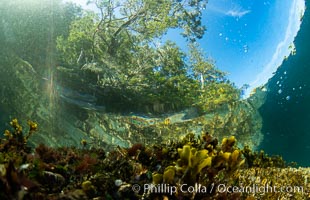
Shallow water reef with coniferous forest hanging over the water, Browning Pass, Vancouver Island.
Location: British Columbia, Canada
Image ID: 35304
Location: British Columbia, Canada
Image ID: 35304
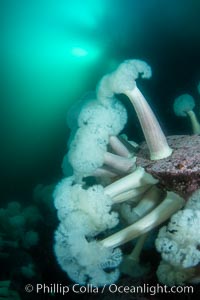
Giant Plumose Anemones cover underwater reef, Browning Pass, northern Vancouver Island, Canada.
Species: Giant plumose anemone, Metridium farcimen
Location: British Columbia, Canada
Image ID: 35305
Species: Giant plumose anemone, Metridium farcimen
Location: British Columbia, Canada
Image ID: 35305
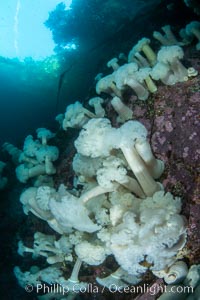
Giant Plumose Anemones cover underwater reef, Browning Pass, northern Vancouver Island, Canada.
Species: Giant plumose anemone, Metridium farcimen
Location: British Columbia, Canada
Image ID: 35306
Species: Giant plumose anemone, Metridium farcimen
Location: British Columbia, Canada
Image ID: 35306
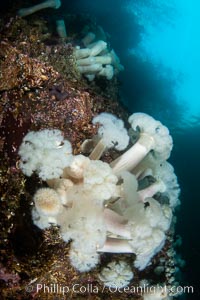
Giant Plumose Anemones cover underwater reef, Browning Pass, northern Vancouver Island, Canada.
Species: Giant plumose anemone, Metridium farcimen
Location: British Columbia, Canada
Image ID: 35307
Species: Giant plumose anemone, Metridium farcimen
Location: British Columbia, Canada
Image ID: 35307
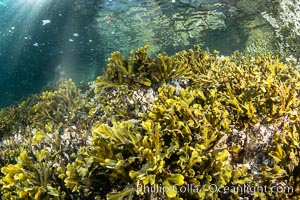
Shallow water reef with coniferous forest hanging over the water, Browning Pass, Vancouver Island.
Location: British Columbia, Canada
Image ID: 35308
Location: British Columbia, Canada
Image ID: 35308
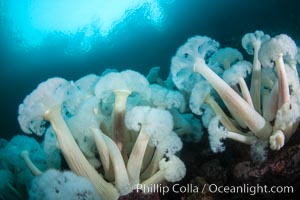
Giant Plumose Anemones cover underwater reef, Browning Pass, northern Vancouver Island, Canada.
Species: Giant plumose anemone, Metridium farcimen
Location: British Columbia, Canada
Image ID: 35324
Species: Giant plumose anemone, Metridium farcimen
Location: British Columbia, Canada
Image ID: 35324
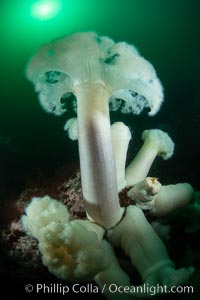
Giant Plumose Anemones cover underwater reef, Browning Pass, northern Vancouver Island, Canada.
Species: Giant plumose anemone, Metridium farcimen
Location: British Columbia, Canada
Image ID: 35329
Species: Giant plumose anemone, Metridium farcimen
Location: British Columbia, Canada
Image ID: 35329
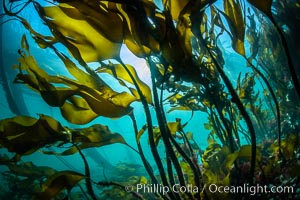
Bull kelp forest near Vancouver Island and Queen Charlotte Strait, Browning Pass, Canada.
Species: Bull kelp, Nereocystis luetkeana
Location: British Columbia, Canada
Image ID: 35331
Species: Bull kelp, Nereocystis luetkeana
Location: British Columbia, Canada
Image ID: 35331
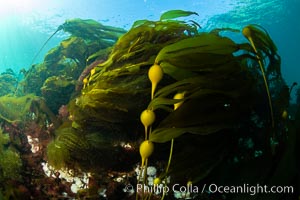
Bull kelp forest near Vancouver Island and Queen Charlotte Strait, Browning Pass, Canada.
Species: Bull kelp, Nereocystis luetkeana
Location: British Columbia, Canada
Image ID: 35337
Species: Bull kelp, Nereocystis luetkeana
Location: British Columbia, Canada
Image ID: 35337
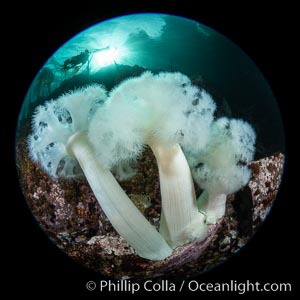
Giant Plumose Anemones cover underwater reef, Browning Pass, northern Vancouver Island, Canada.
Species: Giant plumose anemone, Metridium farcimen
Location: British Columbia, Canada
Image ID: 35340
Species: Giant plumose anemone, Metridium farcimen
Location: British Columbia, Canada
Image ID: 35340
